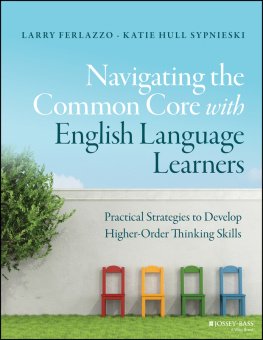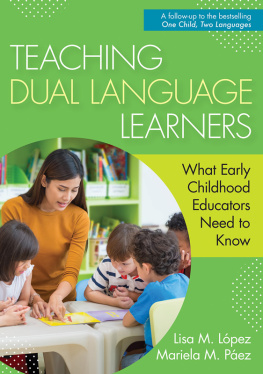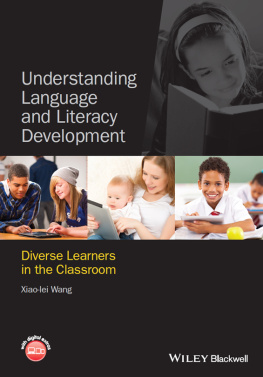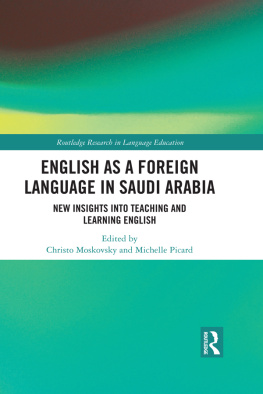Dual-Language
Learners
Strategies
for Teaching
English
Angle Sancho Passe

Published by Redleaf Press
10 Yorkton Court
St. Paul, MN 55117
www.redleafpress.org
2013 by Angle Sancho Passe
All rights reserved. Unless otherwise noted on a specific page, no portion of this publication may be reproduced or transmitted in any form or by any means, electronic or mechanical, including photocopying, recording, or capturing on any information storage and retrieval system, without permission in writing from the publisher, except by a reviewer, who may quote brief passages in a critical article or review to be printed in a magazine or newspaper, or electronically transmitted on radio, television, or the Internet.
First edition 2013
Cover design by Jim Handrigan
Cover photograph Corbis Photography/Veer
Interior design by Douglas Schmitz
Typeset in ITC Mendoza
19 18 17 16 15 14 13 12 1 2 3 4 5 6 7 8
Library of Congress Cataloging-in-Publication Data
Passe, Angle Sancho.
Dual-language learners : strategies for teaching English / Angle Sancho Passe. 1st ed.
p. cm.
Includes bibliographical references.
ISBN 978-1-60554-202-7 (e-book)
1. English languageStudy and teachingForeign speakers. 2. Education, Bilingual. 3. Bilingualism in children. I. Title.
PE1128.A2P327 2012
428.0071dc23
2012025628
To Matthew and Alexander,
and all children learning two languages at home and at school
Contents
W riting and publishing a book is the ultimate group effort, and many people play a part in the process.
First, I want to thank the leaders at Redleaf Press for their interest in and commitment to this project: Linda Hein, David Heath, and Kyra Ostendorf. I am immensely grateful for my editors: Laurie Herrmann for her precise questions and her steady support, Christine Zuchora-Walske for her confident pen, and Carla Valadez for the final touches
I have worked with many colleagues who have shared my passion for teaching and supporting their families. These colleagues have all contributed with their questions, ideas, challenges, and wisdom. I especially thank Julie Anderson, Anita Beaton, Jackie Blahnick, Julie Buresh, Victoria Campoverde, Camila Carrasco, Catherine Cuddeback, Nery Donis, Becky Drong, Lisa Gruenewald, Marian Hassan, Kate Horst, Laura Johansson, Katie Knutson, Mary Mackedanz, Andi Matre, Kathleen ODonnell, Gaby Ortega, Annie Pearson, Susan Rydell, Beth Sandell, Maureen Seiwert, Sandy Simar, Beth Standford, Patricia Torres Ray, Yer Vang, Carol Will, and Cory Woosley.
Finally, a big thank-you to my
I n my family, everyone is . Economic need, personal interest, and political misfortune have inspired my family members to learn French, Arabic, Spanish, German, English, and Catalan over the past four generations.
My life experiences have shaped my language acquisition and multicultural thinking. I was born in French Algeria. My family became refugees in Spain during the Algerian War (195462), when I was a child. I immigrated to the United States as an adult. My first language is French. My second is Spanish. My third is English. My adult children are in French and English. My Minnesotan grandchildren are, too.
I started my teaching career as a French and Spanish instructor. Later I worked as an early childhood teacher, parent educator, and administrator in programs serving both U.S.-born and immigrant families. I have also taught college courses and written publications on dual-language learning. As an education consultant, I meet with and survey immigrant families and educators, and I observe, film, and assess classrooms and child care homes. My specialty is the multilingual classroom in which the children are learning English together but speak different languages at home. I cherish watching children learn, and I enjoy training and coaching their teachers. Helping and bilingual teachers understand their role, discover their strengths, and use their skills effectively is always rewarding.
Why I Wrote This Book
In this book, I share with you both research evidence and personal insights. I propose a thoughtful, commonsense approach to help young children learn English, maintain their home language, and develop the early literacy skills necessary for school readiness and success.
Teaching language to help young children become bilingual and bi-literate is a challenging task. Educators must bridge school literacy and home language while encouraging parents to use their home language. They must use concrete techniques designed for teaching and supporting their families. Intentionality is critical. A hopeful but haphazard approach often frustrates and disappoints students and families as well as educators.
The Term Dual-Language Learner
I use the term dual-language learner rather than the familiar terms English-language learner (ELL) or limited English proficiency (LEP). I believe dual-language learner is the right word to describe a child who is learning both English and a home language. It respects the importance of both languages. English is the practical language needed to succeed in school and the wider world. The home language is the emotional language needed for maintaining family relationships, values, and traditions.
When I present workshops for educators, I ask them to tell me why they have come. Their responses boil down to two basic questions:
1.What are the best ways to teach children who are dual-language learners?
2.What are the best ways to communicate with and support the families of dual-language learners?
I hope to answer these key questions in this book. As you read, you will probably confirm things you already know. You will also learn some new ideas. I hope you will reflect on your current work and decide how to connect what you know with what you do. Together, you and I can improve the education of young children who are dual-language learners!
Focus and Philosophy
In this book, I address educators in multilingual early childhood classrooms who teach in English and support home languages intentionally. I take into account the challenge of supporting home languages without staff who speak these languages or media produced in them. I describe simple techniques you can use to foster dual-language learning, regardless of your resources.
The term early childhood means birth to third grade. I share the philosophy of the National Association for the Education of Young Children (NAEYC) . NAEYC believes early childhood ranges from birth to eight years, because during these years children build the foundation for later academic success. The majority of dual-language learners are in this age group. They are at the beginning of their schooling. Their parents are at the beginning of their own involvement in the formal education of their children. It is a hopeful time and an opportunity to set a positive tone for the future, which is why it makes good sense to support their educators well.
This view of early childhood dovetails with a national education movement called PreK-3rd (Copple and Bredekamp 2009). A PreK-3rd approach integrates the learning experiences of children three to eight years old (from preschool through third grade). Teachers across these grades plan cooperatively and align their resources and instruction to provide an education thats coherent, sequential, and developmentally appropriate from year to year. This movement is gaining momentum as the sciences of child psychology and education become more precise and as educators become more aware of the need for continuity between preschool and the primary grades (Kauerz 2010; Mead 2011). Continuity is especially important for dual-language learners. They must move along the road of language learning and the road of content learning at the same time. If you pay constant attention to the double job of dual-language learners and believe deeply that they can learn, then you will succeed.
Next page







